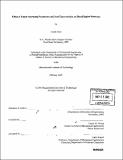Effect of engine operating parameters and fuel characteristics on diesel engine emissions
Author(s)
Acar, Joseph, 1977-
DownloadFull printable version (4.535Mb)
Other Contributors
Massachusetts Institute of Technology. Dept. of Mechanical Engineering.
Advisor
Victor W. Wong.
Terms of use
Metadata
Show full item recordAbstract
To examine the effects of using synthetic Fischer-Tropsch (FT) diesel fuel in a modern compression ignition engine, experiments were conducted on a MY 2002 Cummins 5.9 L diesel engine outfitted with high pressure, common rail fuel injection, a variable geometry turbo charger, cooled EGR and a fully configurable engine management computer. Additionally, the effect of varied injection timing and EGR rates were studied to examine how the engine can be optimized for FT fuel. The test fuels included two standard diesel fuels, one with 400 PPM sulfur content and the other 15 PPM sulfur. The experimental fuels were Syntroleum Corporation's S-1 fuel, as well as blends of 25% S-1 with a balance of 15 or 400 PPM D2. Tests were conducted with three engine operating conditions: 1682 RPM, 474 kPa BMEP; 2011 RPM, 1000 kPa BMEP; 2011 RPM, 1400 kPa BMEP. It was found that FT fuel reduced NOx emissions 19% in low load tests, but alone had little effect in higher load tests. FT fuel reduced particulate matter (PM) emissions in almost all test case, on the order of 25 to 75%. Retarding injection timing and increasing EGR both reduce NOx emissions. In the case of standard fuels, these reduction come at the expense of increased PM. However, FT fuel reduced this effect and allows for more retarded timing and further increased EGR rates to control NO. Blended fuels, containing 25% FT, by volume, and a balance of 15 PPM or 400 PPM fuel, were found to provide most of the benefit of straight FT fuel. The FT/15 blend reduced PM 40% and the FT/400 blend reduced PM 60%.
Description
Thesis (S.M.)--Massachusetts Institute of Technology, Dept. of Mechanical Engineering, 2005. Includes bibliographical references (leaf 32).
Date issued
2005Department
Massachusetts Institute of Technology. Department of Mechanical EngineeringPublisher
Massachusetts Institute of Technology
Keywords
Mechanical Engineering.